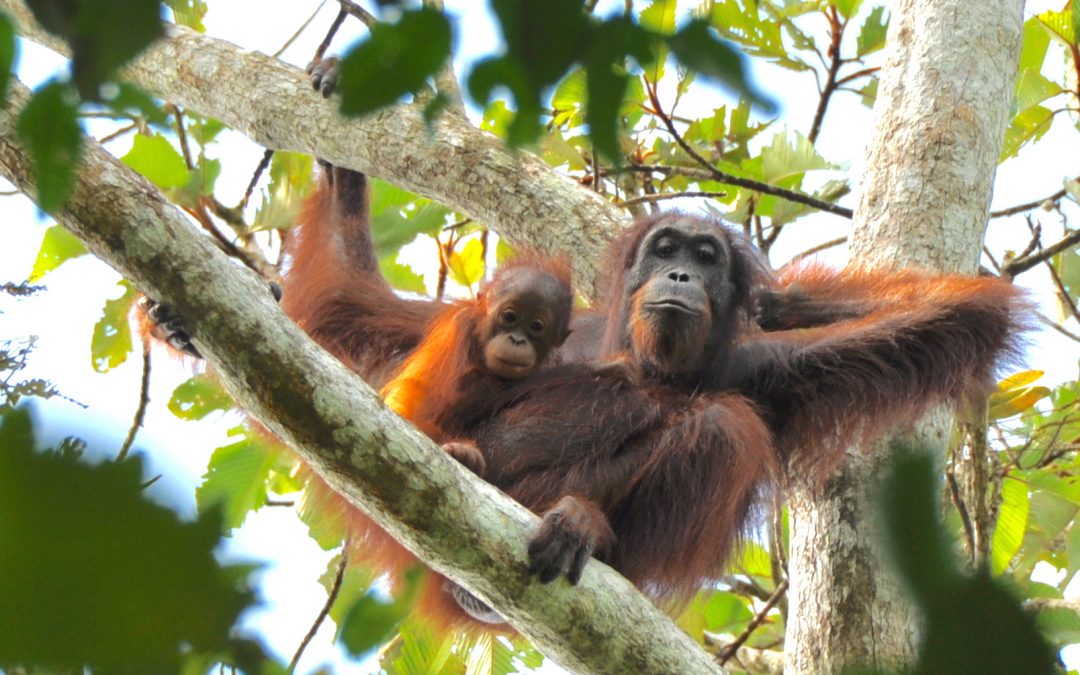 The critically endangered orangutan—one of humankind’s closet living relatives—has become a symbol of wild nature’s vulnerability in the face of human actions and an icon of rainforest conservation.
The critically endangered orangutan—one of humankind’s closet living relatives—has become a symbol of wild nature’s vulnerability in the face of human actions and an icon of rainforest conservation.
New research published today in the journal Science Advances indicates this view overlooks how humans, over thousands of years, fundamentally shaped the orangutan known today.
Ignoring this obscures understanding of orangutans and impacts conservation efforts, said lead author Stephanie Spehar, an associate professor of anthropology at the University of Wisconsin Oshkosh.
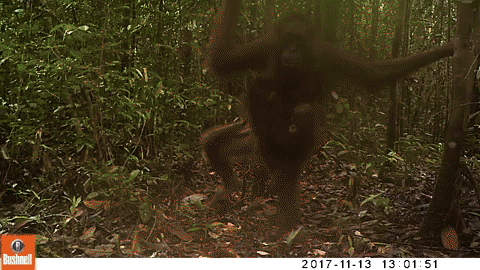
Orangutan walking terrestrially at the Cabang Panti Research Station in Gunung Palung National Park, West Kalimantan, Indonesia. Video by Andrew Marshall
“It was often assumed that environmental factors like fruit availability were primarily responsible for most features of modern-day orangutans, such as the fact that they usually live at low densities and have a restricted geographic distribution,” Spehar said.
“However, the orangutan that existed before modern humans arrived in Southeast Asia 70,000 years ago may have been quite different. Our synthesis of fossil, archeological, genetic and behavioral evidence indicates that long-term interactions with humans shaped orangutans in some pretty profound ways.”
Reexamining the evidence
The study shows that orangutans were once far more widespread and abundant, with orangutan teeth among the most common animal remains in deposits in China, Thailand and Vietnam. These orangutans weathered many environmental changes and may even have lived in a wider range of environments than their modern counterparts.
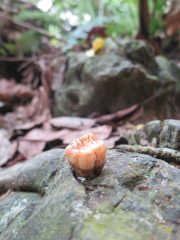
Orangutan fossil tooth. Photo by Gilbert Price
A widespread reduction in orangutan numbers, which occurred around 20,000 years ago, appears to be closely correlated with indicators of human impact, especially the appearance of projectile weapons that make hunting tree-living prey easier, Spehar said. “It suggests that Paleolithic humans were probably hunting orangutans regularly—and as orangutans reproduce very slowly, it doesn’t take much to put a dent in their populations.”
Today, orangutans are only found on the islands of Borneo and Sumatra. The ecology and behavior of modern orangutans probably represents an adaptation to environmental factors and long-term human pressures, especially hunting.
“Acknowledging how orangutans were affected by humans in the past can help us better understand how they respond to human threats now,” said research lead Erik Meijaard, co-director of NGO Borneo Futures and a co-author on the paper.
Recent behavioral studies indicate that orangutan adaptability may be greater than previously thought, he said.
“For example, we always thought that orangutans were mostly arboreal, but when we started putting camera traps in the forest, it turned out that they also walk extensively on the ground in some areas,” Meijaard said.
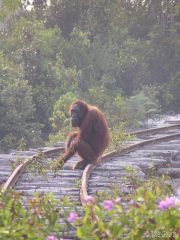
Female bornean organutan in a human-altered landscape. Photo by Serge Wich
Implications for conserving orangutans
Emerging research on orangutans living in heavily human-impacted habitat, such as oil palm and forestry plantations, also highlights that the apes can adjust their behavior to survive in such areas, at least in the short-term.
“These insights are important, because they show us how even well-studied species can be misunderstood due to our preconceptions,” said Douglas Sheil, a tropical ecologist at the Norwegian University of Life Science and a co-author on the paper.
“This also is a crucial realization for orangutan conservation. If we had known sooner that orangutans survive in selectively logged forests, we could have developed conservation strategies that incorporate these habitats much earlier. This could have saved many thousands of orangutans.”
The good news is that orangutans can be conserved in a much larger part of the landscape than previously thought.
“We urgently need to explore these opportunities,” Sheil said.
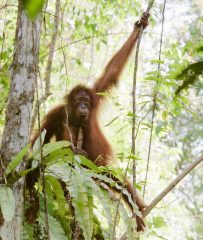
Orangutan in heavily disturbed landscape. Photo by Stephanie Spehar.
Serge Wich, another coauthor on the paper and a professor at Liverpool John Moores University, said this is especially important for the Tapanuli orangutan, a new species just described in 2017. “There are only 800 left in fragmented forest areas, so these findings must be applied immediately.”
The researchers call for a multifaceted approach to orangutan conservation that incorporates human-dominated landscapes but reduces hunting and increases habitat quality and connectivity.
Such an approach requires developing sound policies, enforcing existing laws and promoting cooperation among stakeholders.
This research demonstrates that orangutans can be resilient in the face of some human interactions, said Marc Ancrenaz, director of French NGO Hutan and coauthor on the paper.
“This offers hope. If we humans manage things correctly, there can be room for the orangutan in the Anthropocene,” he said.
In the field / in the classroom
The research article published today is part of Spehar’s larger research program at UW Oshkosh that focuses on understanding how orangutans and other primates respond to different environmental conditions and human activities, with an eye toward supporting sound conservation policy.
“I generally approach these questions by collecting field data on wild orangutans living in various types of habitats … from relatively undisturbed like protected forests to heavily human-altered like forestry plantations,” she said. “This paper is a bit different because my coauthors and I tried to bring together information from a wide range of sources and from the deep past, as well as now, to answer big questions about why orangutans are the way they are and how we can conserve them.”
Spehar often involves students in data analysis and sometimes even in the data collection in the field.
In the class room at UW Oshkosh, she has taught a variety of classes that touch on a number of topics that her research incorporates, including human evolution, primate behavior and wildlife conservation. Last semester, she co-taught an Honors seminar called The Anthropocene, which covered the current human-dominated epoch.
Learn more:

